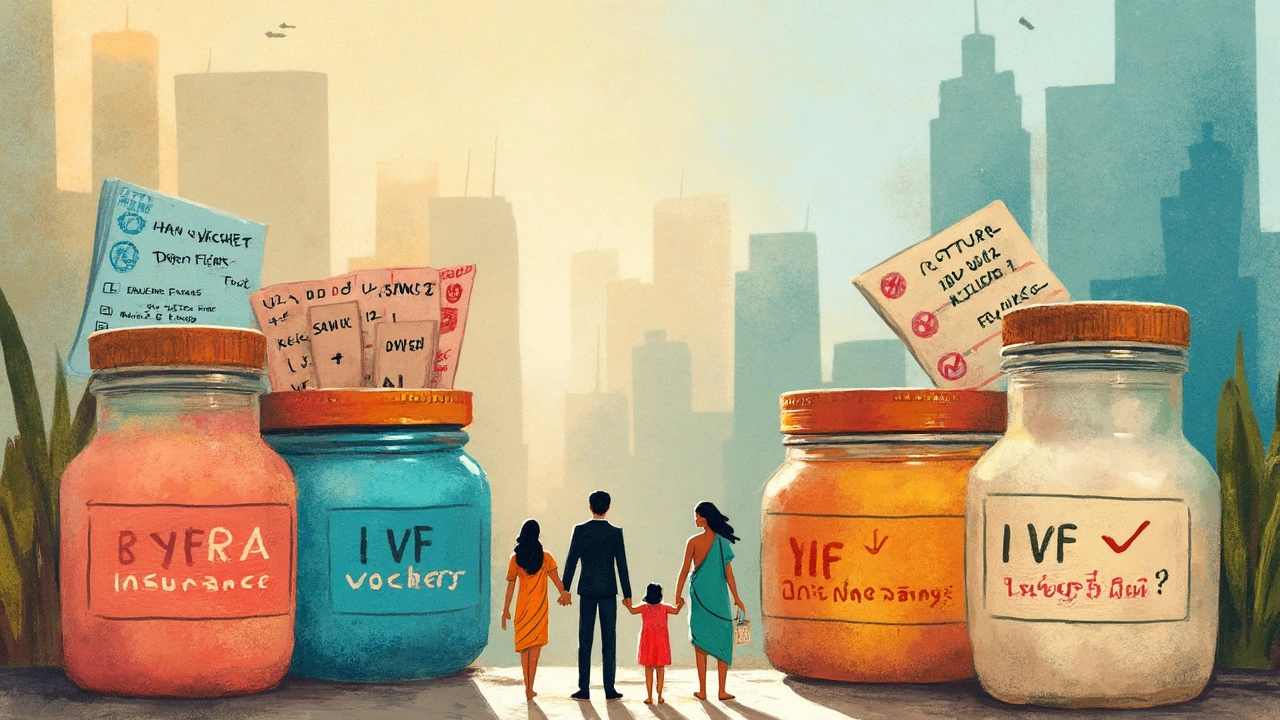Picture this: you’re eager to start a family, but things aren’t going as planned. You hear about IVF—that “miracle procedure” many people whisper about—but then you start Googling prices. Let’s just say, the sticker shock is real. IVF isn’t some niche luxury anymore. Everyone from your neighbors to your favorite TV characters is talking about it. But no one ever sits down and tells you—plain and simple—how much it’s actually going to set you back in the US. That’s what we’re doing here. I’m breaking the numbers down, sharing real stories, and throwing in hacks I wish someone had told me sooner. Spoiler: it’s more complicated (and sometimes pricier) than the first number you see on a clinic’s website.
How Much Does IVF Really Cost in the US?
The moment you ask “How much does IVF cost in the US?” you get a wild range of answers. Clinics throw around averages like $12,000 to $15,000 per cycle—that’s just for the basics. The Society for Assisted Reproductive Technology (SART) reports that the national average for a base IVF cycle in 2024 is about $14,000. But let’s be real: rarely anyone walks out paying just that.
When people in forums and Facebook groups talk about their real expenses, numbers climb up fast. Why? Because base price rarely includes everything you actually need. Medications usually add $3,000 to $6,000—a surprise for many. There’s extra testing, consultations, and monitoring. Some clinics bundle these in (sometimes labeled as “all-inclusive packages”—which usually still have fine print), but many don’t. Toss in procedures like ICSI (intracytoplasmic sperm injection), which is almost standard now and runs $1,500 to $3,000, and assisted hatching (another $500+). Embryo freezing to keep options open? Expect $800 to $1,500 with annual storage fees of $300-$600 per year.
Let’s be honest, it’s easy to get frustrated when each appointment brings another unknown bill. According to RESOLVE, the National Infertility Association, the total out-of-pocket cost per complete IVF attempt in the US hovers between $15,000 and $25,000—sometimes even higher. A few clinics in smaller cities or less competitive markets might offer cycles as low as $10,000-$12,000, but add-on costs usually bring you right back to the average.
“Patients should ask specifically what’s included in the quoted cycle fee and what isn’t. Otherwise, the price can easily double,” advises Dr. Serena H. Chen, founding director at Cooperman Barnabas fertility center, quoted in a recent New York Times health piece.
Another thing nobody tells you: most people need more than one cycle. On average, it takes 2.7 cycles to achieve a live birth, based on SART’s 2023 data. So, it’s not just about the base IVF cost—it’s about budgeting for multiple rounds and the unexpected extras that come with each one.
Why Does IVF Cost So Much?
If you’re shocked at the numbers, you’re not alone. The high price of IVF in the US is actually notorious worldwide—Europeans pay half as much, and Indians even less. So what gives? First, the US healthcare system and insurance landscape are a unique beast. Most insurance plans treat IVF and fertility treatments as optional or “not medically necessary,” so unless you’re lucky enough to live in a state with a mandate (like New York or Massachusetts), you pay almost everything out of pocket.
A big chunk of the expense is medications. Ovarian stimulation drugs aren’t covered by many plans and can set you back thousands per cycle. Then there’s the staff: fertility clinics employ specialized doctors, embryologists who handle eggs and sperm, anesthesiologists for egg retrievals, plus lab techs. The equipment in these clinics is cutting-edge—and far from cheap to maintain and run.
Don’t forget the various lab procedures. ICSI, genetic testing (like PGT), and cryopreservation aren’t included in many base plans. These aren’t “extras” for many people—they’re standard, especially for those with male factor infertility or who want to avoid certain genetic risks. Preimplantation Genetic Testing (PGT-A) can range from $3,500 to $7,500 and is out of reach for plenty of families. Also, IVF is time-intensive. Monitoring needs frequent ultrasounds and bloodwork. Each cycle requires near-daily visits for 10 to 14 days, followed by surgical egg retrieval, lab handling and embryo transfer.
There’s also the business side. US clinics operate in a competitive, private market. Many are run as businesses, not charities, so overheads (think rent, marketing, malpractice insurance, maintenance, staff salaries) get baked into the price. Compare that with countries that have subsidized systems or strict pricing regulations, and you’ll see where the extra dollars go.
To add to the headache, geographic location makes a huge difference. IVF in New York or LA can be $18,000+ per cycle before meds and fees. In middle America? Maybe $13,000 to $15,000. No two clinics are priced the same, and sometimes, “affordable” programs come with long waits or less individualized care.

What Does the Typical US IVF Package Include?
It might look tempting when you see an “IVF package deal” online, but always dig into what’s covered. Here’s what’s usually in or out:
- Initial consultation: Sometimes included, often billed separately ($250-$500)
- Lab tests and screening: Hormone panels, infectious disease screening, semen analysis—not always included
- Ovarian stimulation drugs: Almost never in the base price, add $3,000 to $6,000
- Monitoring & ultrasounds: Usually in, but ask how many visits are covered
- Egg retrieval procedure: In, but anesthesia may be separate
- Lab work: Fertilization, embryo growth, but extras (like ICSI or PGT) come with a surcharge
- Embryo transfer: One, maybe two transfers included
- Embryo freezing (cryopreservation): Sometimes covered for a year, sometimes extra from the start
- Storage fees: Nearly always billed annually after the first year
- Follow-up visits: May be included, but only for a set period
Think of the typical package as “bare bones.” You’ll almost always face additional costs the further you go. If you want procedures like assisted hatching or more advanced embryo biopsies, prices can skyrocket. Some clinics sell “IVF refund programs” or “multi-cycle packages” where you pay upfront for several attempts and get a partial refund if you don’t have a baby—but again, read the fine print. These typically run $20,000 to $30,000 for three cycles, with lots of exclusions.
Ask about:
- How many egg retrievals and embryo transfers are included?
- Which medications are NOT included?
- When do storage fees start?
- Are there discounts for paying upfront or cash?
- Are genetic screenings, ICSI, or other lab extras necessary for your case?
Shoppers should play detective—call a few clinics, compare itemized printouts, and check reviews from others. If it sounds too good to be true, there’s probably a catch hidden in the paperwork.
Paying for IVF: Insurance, Loans, and Sneaky Savings
Don’t be ashamed to ask about every payment option out there—because hardly anyone pays for IVF out of pocket without feeling the pinch. First, check your insurance. The National Conference of State Legislatures notes that only 21 states have any fertility coverage requirements. Among them, just 13 mandate IVF coverage, often with lots of hoops to jump through, like being under a certain age, married, or having tried natural conception first. Even then, insurers may cap payouts, limit cycles, or cover only certain parts of the process.
If your employer is big enough, you might be in luck. More Fortune 500 firms, like Google and Starbucks, now offer IVF coverage as a perk, due to employee demand. If you’re changing jobs or negotiating a promotion, this is worth asking about. Federal employees and military families have mixed options—TRICARE, for example, doesn’t cover IVF, but some branches offer grants for certain bases.
No coverage? Loans are the next stop. Specialized IVF lenders (like CapexMD, LendingClub) offer medical loans designed for fertility treatments, with terms similar to car loans (5-12% interest, 2-5 years to pay off). Medical credit cards, like CareCredit, can be handy but carry high interest if you don’t pay down fast. Some clinics partner with lenders and offer “financing packs.” Compare rates. Avoid payday loans or credit cards—high interest is a quick route to debt stress. A small but growing number of banks now allow IVF as part of broader personal loans as medical expenses become more common.
Patient assistance programs are often overlooked. Drug manufacturers (Merck, Ferring, EMD Serono) sometimes run discount or free-meds programs for those who qualify financially. Nonprofits occasionally give out grants or raffle off “free cycles,” though competition is fierce. Military veterans can check with local VA clinics about coverage under special cases. Some clinics advertise their own “shared risk” or “guarantee” programs—if you don’t have a baby after X cycles, you get a partial refund. These are worth exploring, with an eye on the fine print.
One more tip: Fertility tourism is becoming popular. Some Americans travel to Mexico, Czech Republic, or even India (places like Delhi and Mumbai have reputable clinics) for high-quality IVF at half the price, combining the experience with a quiet vacation. But travel costs, visa complications, and follow-up remain hurdles. Others join patient support groups (like r/Infertility on Reddit) to swap hacks for saving on drugs, find local discounts, or split medication orders legally.

FAQs, Success Rates, and What Real Patients Wish They Knew
Still reading? Good. This section is where the rubber meets the road. People have so many questions about IVF—cost is only the beginning:
- Does higher cost mean better success? Not really. Some boutique clinics have great success rates and premium prices, others don’t. Look up the SART or CDC site for your clinic’s real yearly success stats. Compare outcomes in your age or diagnosis group. Sometimes smaller, lower-cost clinics quietly outperform the big names.
- What if it takes more than one cycle? Most people need 2-3 tries. Budget accordingly, both emotionally and financially. Some clinics offer “multi-cycle discounts,” but these vary and may have strict eligibility.
- Are there any surprise costs nobody talks about? Yes. Extra blood tests, anesthesia, embryo monitoring beyond the first cycle, and emotional support sessions. Sometimes unexpected medical issues (complications from stimulation, egg retrieval) bring ER visits and unplanned bills.
- Is there any financial help for LGBTQ+ or single parents? A few nonprofits and clinics offer dedicated programs or grants. Pre-IVF legal consults for donor parents or same-sex couples may be extra.
- How do US IVF costs stack up globally? US IVF costs are among the world’s highest. Europe and Asia often offer similar quality at a fraction of the price, but travel and aftercare can complicate things. Some US clinics also coordinate with overseas labs for part of the process.
- What can I do to keep expenses under control? Request an itemized estimate before you start. Get all agreements in writing. Shop around. Don’t be afraid to negotiate smaller fees or ask about low-cost drug options. Ask your doctor if lower-cost medication protocols would work for your case. Join support groups for discounts on unused medications or referrals.
The most common advice from real IVF patients? Prepare yourself: emotionally and financially. The ups and downs are real. Many wish they’d asked more questions up front or called multiple clinics before picking their specialist. Don’t hesitate to advocate for yourself; the costs are steep, but knowledge puts some control back in your hands.

 Coping with Your Husband After Heart Surgery
Coping with Your Husband After Heart Surgery
 Can You Kneel After Knee Replacement? What Really Happens and When You Can Expect to Kneel Again
Can You Kneel After Knee Replacement? What Really Happens and When You Can Expect to Kneel Again
 Understanding Trazodone: Is It a Narcotic?
Understanding Trazodone: Is It a Narcotic?
 Unveiling the World's Most Common Illness and Its Impact on Medical Tourism
Unveiling the World's Most Common Illness and Its Impact on Medical Tourism
 Heart Surgery Life Expectancy: What to Expect After the Procedure
Heart Surgery Life Expectancy: What to Expect After the Procedure